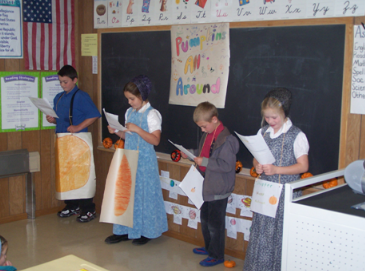
Today in the Teaching Around the World blog post series, we’re hearing from Heather of the wonderful blog, HoJo’s Teaching Adventures. Heather has taught grades K-6 as a classroom teacher, ELL teacher, Title I teacher, Reading Recovery, special education teacher, and special education overseer. She recently started working as an adjunct professor. For a time, Heather taught in a Hutterite colony, which is similar to an Amish community. It was a fantastic experience for her and I’m thrilled she’s going to share it with us here in such detail. Thank you, Heather!
How did you find yourself teaching in your community?
I stumbled into teaching on a Hutterite colony by accident and a bit of luck. Growing up, there were three Hutterite colony schools within my own small K-12 school district of 250 students. These three colonies attributed to roughly 100 of these K-8 students between them. It was my senior year of college and I was interviewing for jobs across the state. I saw my hometown advertise for an elementary position, sent an e-mail inquiring about it, heard it was at a Hutterite colony, and clicked the delete button. The next day my mom called to tell me that I had an interview set up for the Friday before my brother’s graduation because she knew I would be home. It turns our the new superintendent had recognized my name from my brother, called my parents, and set up an interview for me. I wanted to cancel, but my mom said it would be good practice to help me land a future job. Not one to argue with my mother, I went… A week later I was offered a job. Thrilled at my first job offer, I accepted!
What is like to live in your community in your experience?
I get asked all the time whether I lived at the colony. The answer is no. I lived in a town roughly 20 miles away from the colony. I commuted there each day, often carpooling with coworkers. I also did not have to wear a dress. Even though the women and girls wear dresses daily, I was considered an “English” woman, so I did not have to dress like them. However, I was expected to wear nothing shorter than capris and short or long sleeve shirts. No cut-offs/sleeveless, nothing low cut, and no short skirts or shorts.

What are the biggest differences between schools where you live and American schools?
There are many differences between the typical American schools and Hutterite colonies. First, many of the grades are combined. For example, my first year there I taught 16 students in third and fourth grades. My second year teaching at a Hutterite colony, I taught only twelve students, but they were in second, third, and fourth grades. One of the colonies in our district taught all K-8 students with one teacher and a full-time paraprofessional. It just depends on the size of the colony.
Another difference is the parents. I’ve never seen such supportive parents in the four school districts I’ve been in. However, they also weren’t helicopter parents. They wanted their students to learn the basics in reading, writing, and ‘rithmetic, and they fully supported the teachers. In today’s world, I’m seeing less of this, so it was greatly appreciated!
Discipline was another major difference while teaching at a colony school. The students are raised by a community as a whole, so group rewards worked wonders! I did typical teacher rewards in my classroom, but we could freely talk about God (as long as I respected their religious differences from mine) and parents often encouraged me to tell their children that God would not want them to act in such a way.
Tell us the basics about your job. How many students do you have? How long is your school day? What subjects do you teach?
During my two years teaching at a colony school, I taught all typically elementary subjects and all specials classes except music. (There was a teacher that traveled to colony schools for 30 minutes of music weekly.) I had to find time for library, PE, computers, art, and everything else our standards cover. Not all colony schools are run the same way, but that is what the school I was at did.
My hours were 8-4 just like anyone else in my district. However, there were some days when we would not have school. Easter Monday and Easter Tuesday were holidays celebrated by the colony. We did not have school on either of those days. There were also several times during the year when the colony would be doing a major activity that involved nearly everyone’s help, such as butchering chickens. On these days the younger K-3 students may be in school, but the older boys would help butcher and the older girls would go babysit the babies and toddlers so their mothers could help clean the birds. Sometimes the upper grades teacher would have boys gone to help clean the hog or turkey barns, to travel to sell pigs, or a wide variety of other activities where they were helping the men. It was always interesting to say the least!
What is a typical day like in your classroom? Tell us about your daily schedule or routines.
My schedule was very similar to any other elementary teacher’s, except that I had to squeeze in more than one grade each day. From 8:30 when the kids walked in the door until 10 all I taught was math. We did morning routines (which was just math facts) and then went straight into math lessons. From 10:15-11:30 all I taught was reading. The students were dismissed to lunch at 11:30, and teachers went up to grab our food from the community kitchen at 11:40. The kids returned around 12:15 and from then until 3 I taught phonics, grammar, writing, social studies, science, guided reading, all specials, and anything else I needed to cover. The first year was easy because I combined the social studies and science for third and fourth grade. However, the second year I had to split them because of student abilities. That year was tricky.
My mom was a sub in the school district for many years, but had never taught in a Hutterite colony until she subbed in my classroom. The first time she did she went home exhausted and said, “I just don’t know how you find the time. I only got to half of what you planned, and I never sat down.” I just smiled and laughed because that’s exactly how every day went.

What’s the best part about teaching where you are?
The people at the colony were great! Had my parents not moved to the other side of the state, I think Iwould still be teaching there to this day. Another great part about teaching at a Hutterite colony was the freedom to teach what and how I wanted to. In my two years there, I saw an administrator seven times. Four of those were to be evaluated, once was during summer school when he dropped off textbooks, and the other two were for concerts and graduation.
What’s the toughest part?
The hardest part about teaching at a Hutterite colony was keeping everyone happy. My school administrators did not always realize how the colony setting was different and how every “clicked”. The colony “bosses” (the minister, and also the treasurer who distributed money) wanted us to follow their rules as much as we could. We were also in a tough position because the German school teachers were supposed to relay all of our messages to the bosses, which sometimes meant delays in communication. So trying to keep so many people happy could be quite the balancing act! Another thing that was hard at first was the accent of the students. If you have not heard a thick German accent, it takes some getting used to!
What advice would you give teachers who would like to teach in your city/country? Are the school systems looking to hire teachers internationally?
Teaching at a Hutterite colony is not for the weak of heart! You have to get used to multiple grades, working with ELL students all day every day, be organized 100% of the time (which is exactly why I made one of my classroom chores keeping track of my clipboard! I never knew where I put the darn thing!), and ready to work with a variety of different people. It was an extremely challenging job, but I also think it was the position that made me the teacher I am today. I had very little support outside of the four other people I worked with, and it was a LOT of hours. I had no choice but to sink or swim, and I wanted to swim. Hutterite or not, students deserve our very best!
Hutterite teaching positions are often some of the hardest to fill. This is in part because you have to drive to work each day, and because you teach more grade levels/classes than the average teacher in a town school. However, the pay is often the same. While I had 16 students across two grades, there were teachers in town with 3-12 kids in one grade. Yet we were paid the same. If none of this scares you, check out Montana, South Dakota, Minnesota, and North Dakota to see if there are any open positions this spring. I’m sure you’ll see a few!

Is there anything else you’d like to share about your experiences with Hutterite culture?
One of the things I found so interesting about the Hutterite culture was their sense of community. “And all that believed were together, and had all things common; And sold their possessions and goods, and parted them to all men, as every man had need. And they, continuing daily, with one accord in the temple, and breaking bread from house to house, did eat their meat with gladness and singleness of heart, Praising God, and having favor with all people. And the Lord added to the church daily such as should be saved.” (Acts 2:44-47– taken from Hutterites.org.)
Even students of a young age truly believed in the community approach. Students looked out for one another, and not just older siblings, but all students. Yes, they had their typical “kid” moments, but they often would go out of their way to tutor younger students, include everyone in games, and just be nice in general. During my two years working there I did not buy any jelly, salsa, bread, and other goods. It was provided to me for free by the colony. I also still have potholders, dish towels, and slippers that were made for me. The community members treated me as though I were part of their extended family. I provided the service of teaching their children, and they provided me with a free, homemade lunch each day and innumerable goods.
Another interesting thing to note is how structured the Hutterite children’s day is. Breakfast is at 7. German school starts at 7:30 and concludes at 8:30, which is when students go to “English” school – where I taught. School concluded at 3, and the students would often run home for a small snack or check in on their jobs. At 4 they again went to German school until 5. Church is then at 6, with supper being served at 6:30. After supper the kids do chores or play. They are all supposed to be in their homes by 8 pm. Granted this schedule can vary slightly from colony to colony, but I’m sure they are all similar.
Hutterites are similar to Amish in several ways, but very different in others. Like the Amish, they were formed due to religious beliefs. However, Hutterites live in colonies of 50-150 people away from the general public. They do not own TVs or radios, but they do drive pick-ups, vans, and other vehicles. Each colony has something they do to make a living. The colony I worked at were farmers. They had nearly 20,000 acres of land, three turkey barns, and multiple hog barns. Another colony in the school district I worked in created granite countertops and goods. Each colony specializes in something that will allow them to provide for all of the people at the colony.
Children are welcomed into the Hutterite community at age 5. Prior to that they are not allowed to go to church, eat with the rest of the community, or go to school. At age 15 teenagers are considered adults. For meals, children eat in a separate room from the adults. Both children and adults sit by gender and age. The same goes for church.
Boys and girls are typically given a job around age seven or eight. Boys often start helping in the garden at that time while girls begin babysitting. As the boys get older they are given different apprentice jobs around the colony – carpenter, plumber, hog barns, turkey barns, blacksmith, etc. They rotate through these jobs so they can get a good idea of all of them. At age 17 girls begin to help with the cooking in the kitchen.
Women take turns cooking all the food for the colony for one week at a time. The women also sew much of the clothing their family wears, help in the garden during planting and harvest, take turns canning in the summer, keep their houses meticulously clean, and raise the children. The men each have a specific job. They can be mechanics, semi drivers, ministers, treasurer, German school teacher, and many others.
Colony children only have to go to school through eighth grade. At that time there is a law in South Dakota that says their religious way of life and apprentice type lifestyle are enough for their children to be successful colony citizens. However, in recent years, many SD colonies are starting to see the benefits of high school and how helpful it is for their children to continue making the colonies successful into the future. Some colonies still do not have high school, while others are letting just boys attend, and still others are encouraging boys and girls to attend and receive their diploma.
Each colony is different. I was fortunate enough to be at one of the more liberal colonies. We could talk about Santa during the Christmas season, and we even had a monster house one year for Halloween. (Although it was frowned upon to talk about ghosts, goblins, and witches.) Hutterite children love technology, so showing any short educational video or movie always got their attention! The students also loved using the internet. However, I know there are other colonies who do not allow school children to use the internet or computers at all.
If you happen to find yourself teaching in a colony school, please ask questions as to what is and is not allowed. Respect the culture. Even if it is a hassle to get permission before doing activities, please do so! You do not want to disrespect the elders and their wishes. My two years teaching at a Hutterite colony were some of the best teaching years I’ve had so far! I had to work harder than ever, but it was worth every second!
Do you have questions for Heather about teaching in a Hutterite colony? Feel free to ask in the comment section below. Or, if you teach in an unusual place and would like to be featured in this space, send me an email. I would love to share your story!

Angela Watson
Founder and Writer
Sign up to get new Truth for Teachers articles in your inbox
Discussion
OR

Join our
community
of educators
If you are a teacher who is interested in contributing to the Truth for Teachers website, please click here for more information.
















I have taught for four years on a Colony in Alberta with 25 students K-9. Its just me an my paraprofessional. No technology is allowed. I can confirm you are constantly busy. Teaching 9 grades at once is a HUGE challenge, everyone is ELL, you still have the same learning challenges as English schools, and a Division with high expectations and Provincial Exams to prepare for. Learn to bounce because that is what you do all day. Regular school teacher complain about lack of prep time, well, on a Colony there is no prep time, no down time, no sit and contemplate your next lesson time, it is go time. I’m heading into year 5 in the fall, heaven help me and keep me.
Hi Robert. I know this is an older post but I know there is a colony teaching position coming up in about 4 months. I would love to teach there however I have no experience with the younger grades or resources. What would you recommend doing to get ready for a position like that?
Thank you Lori
I love teaching at my Hutterite colony!!! I wouldn’t trade it for the world.
Hello. I am working with a virtual school that provides online courses to high school colony students. The teachers want to make their courses more relevant to the students’ lives so that they will stay in high school and complete more courses. They want to increase the graduate rate of colony students. How might the teachers adjust their courses to more relevant to colony life? Thanks.